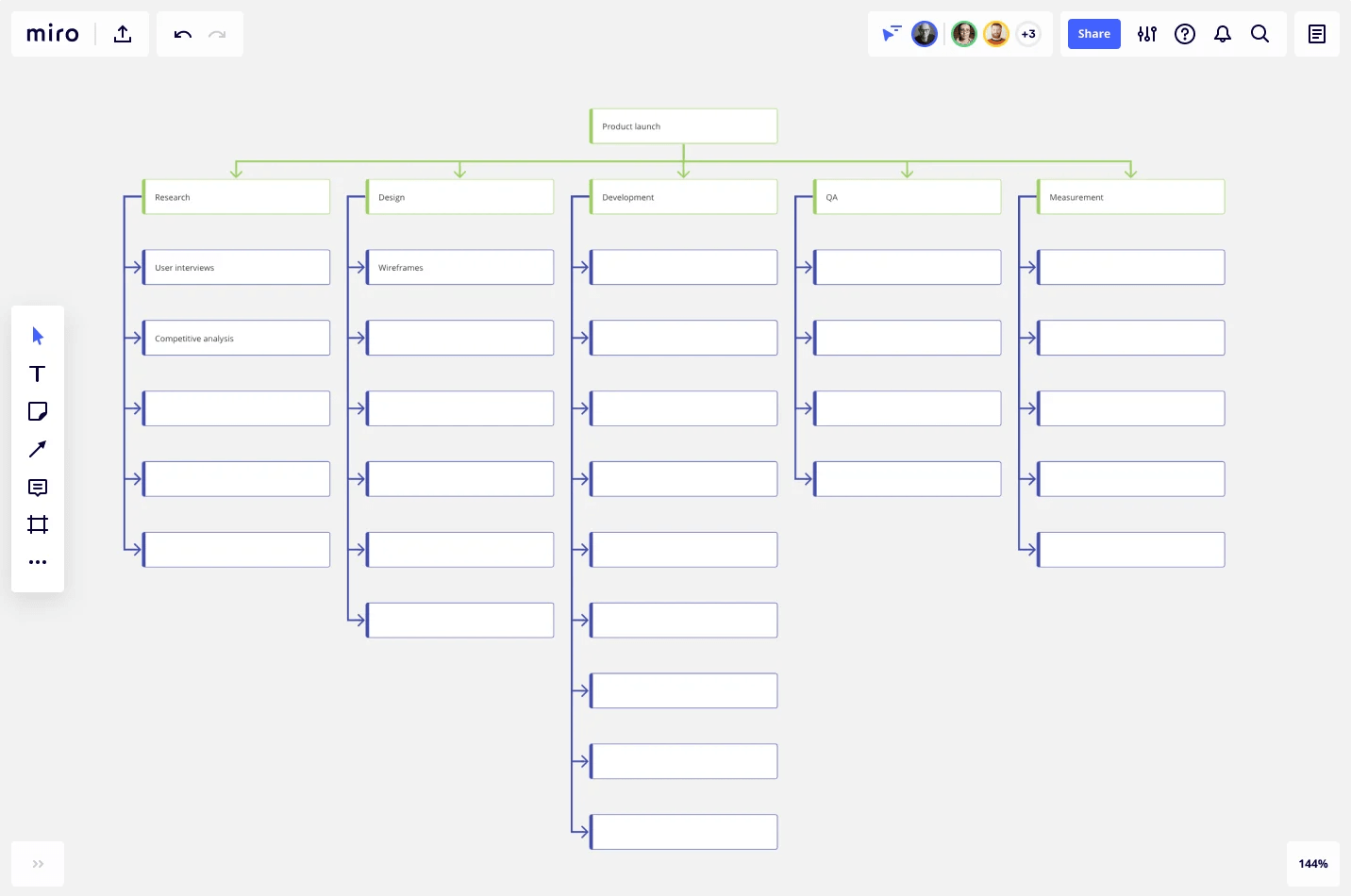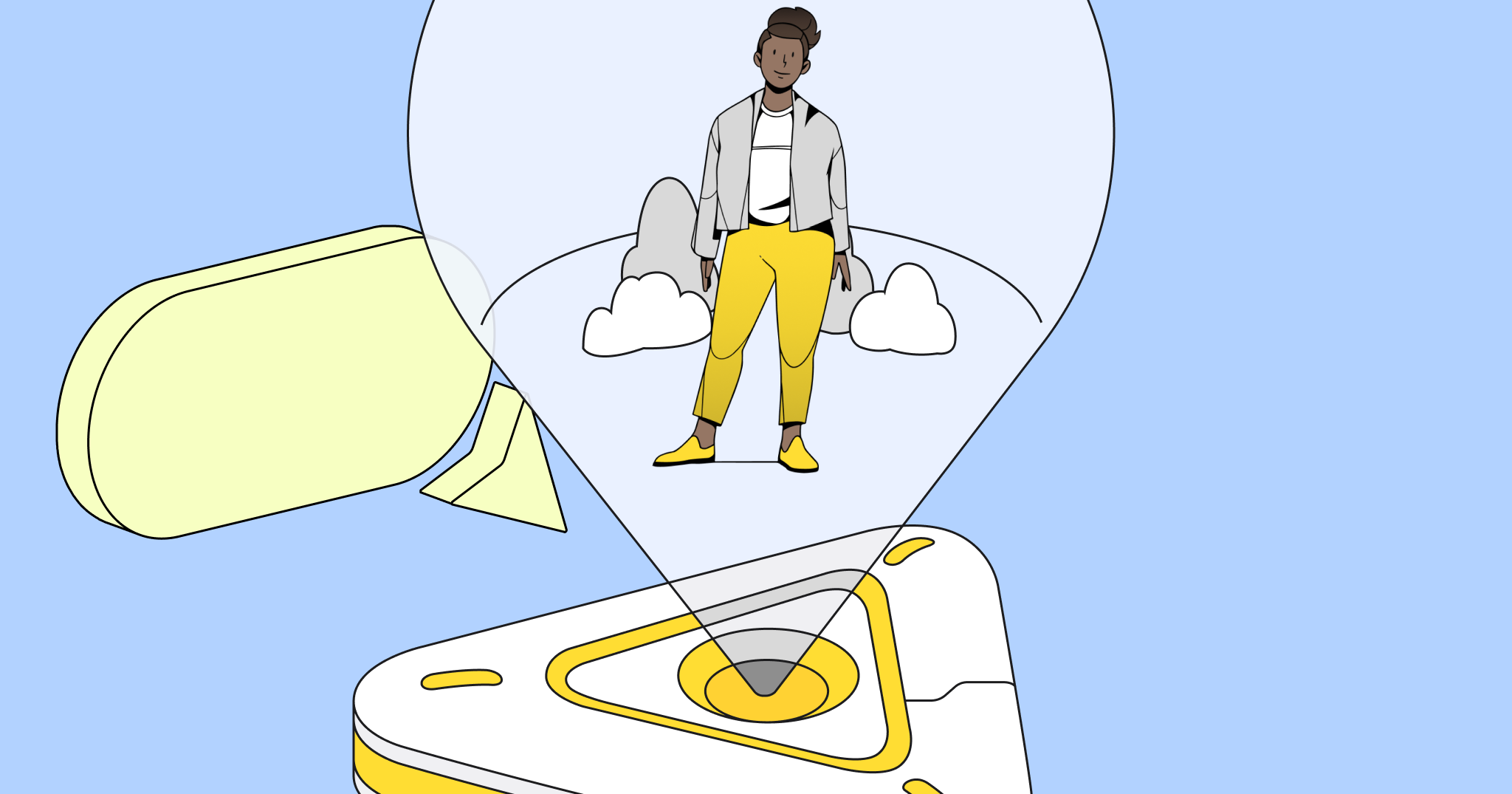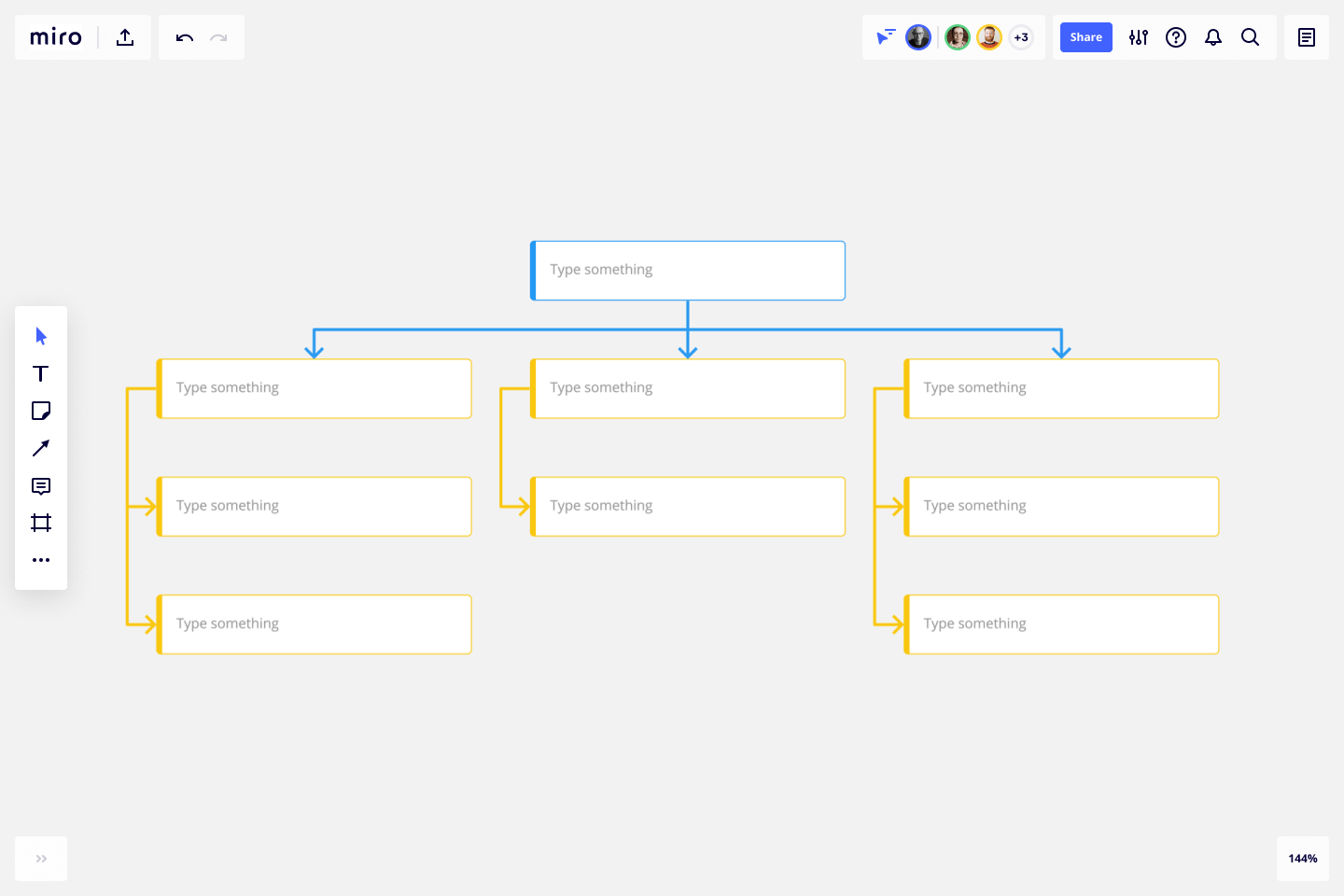Every day, Miro users are creating and collaborating in ways we’d never dreamed up. It’s only by seeing all these projects in the wild we get a glimpse into the possibilities. And what we’ve seen so far is amazing.
Planning out a complex project can seem unmanageable at first. With so many tasks, deliverables, and activities to keep track of, it’s easy for projects to fall through the cracks. Using a work breakdown structure enables you to quickly break down the project’s scope, including key tasks and activities.
A work breakdown structure is a project management tool that lays out everything you must accomplish to finish a project, organizes these tasks into multiple levels, and display these elements visually.
The main thing to note about work breakdown structures is that, despite the name, they are not used to break down work! Rather, they are used to break down deliverables. By using a work breakdown structure, you can get a better understanding of what you need to do to finish the project, how to estimate resources, and how to manage a phased schedule of tasks.
But what does that mean, and how do you do it?
This blog post is designed to help you create a work breakdown structure for software implementation, for an app, or any other project. By the end of the blog, you’ll feel comfortable creating a work breakdown structure of your own, sharing with your teammates, and planning projects with confidence.
Many people have already been sharing their boards on social media and in the Miro online community, but we wanted to find a way to bring all of these incredible examples together in a dedicated place that’s useful and actionable for everyone who uses Miro.
Creating a work breakdown structure
Creating a work breakdown structure is an effective way of distilling your team’s work into small, bite-sized pieces. By using the tool, you can break down a complicated project into well-defined elements that make the project more manageable.
To create a work breakdown structure, you start with the key deliverables, and then you work backward to identify all of the tasks and activities that you need to accomplish to finish the project. You then outline these steps in an organizational chart. The final deliverable sits at the top of the chart, while the levels branching out below divide the project into phases, smaller deliverables, and tasks.
Building a work breakdown structure invites you to think about the project in an outcome-oriented way. Since you’re starting with deliverables, you can easily break up the project and then plan, schedule, and execute tasks. When combined with Gantt chart templates, a work breakdown structure can really set you and your team up for success.
Why use a work breakdown structure?
Think of a work breakdown structure as a map. Just as you’d never start driving to a new place without consulting a map first, it’s a good idea to create and understand your work breakdown structure before you embark on a new project.
Put more concretely, the work breakdown structure defines all the tasks you need to achieve in order to finish the project — and the order in which you need to do them. Visualizing the project this way, and then sharing your visualization with teammates, reduces the chances for misunderstandings. Before you even start the project, you know what to do, who is doing it, what they need, and when it should get done.
In other words, an effective work breakdown structure makes project management so much easier. It helps you estimate costs, allocate resources, and assess risks, while avoiding scope creep, missed deadlines, and cost overrun.
The 5 elements of a work breakdown structure
A work breakdown structure is defined by five key elements. While every work breakdown structure is a little different, they each share these core traits.
As you’re creating your own work breakdown structure, think of these five elements as a checklist. To make sure you’re on the right track, it’s a good idea to double check your work breakdown structure against this list.
1. Hierarchical
Every work breakdown structure is hierarchical. That means every “child” task on the graph has a hierarchical relationship with its “parent” task. Taken together, all of the child tasks are necessary to complete the parent task — and the project as a whole. Each subsequent layer of the chart represents an increasingly detailed description of the deliverables you must complete to finish the project.
2. Definable
One of the reasons a work breakdown structure is so useful is that it forces you to define a scope for the project. To draw the chart, you have to stick to the scope — or you’ll keep drawing forever and never actually get to the project! A good work breakdown structure has well-defined parameters that you and your collaborators can easily describe and understand. If you onboarded a new teammate in the middle of the project, you should be able to show them the chart to quickly get them up to speed.
3. Manageable
A work breakdown structure must be manageable in the sense that each task can be delegated to another team member, who can then complete it within the allotted time frame. Put differently, the chart should not contain more tasks than your teammates can handle, and it should not contain so few tasks that they don’t actually comprise a project.
4. Measurable
When we think about measurement, one of the first things that come to mind is units. Units are a core component of a work breakdown structure. Work breakdown structures are broken down into units of time, cost, and progress, each of which can be used to track your team’s performance. A project has a start date, an end date, a budget, and measurable ways of understanding how well you’re progressing. All of that information has to go into your work breakdown structure.
5. Adaptable
Of course, there’s always a chance your project will evolve once you start working on it. Sometimes the project scope gets larger or smaller, sometimes you add a new teammate or someone leaves, sometimes there are additional deliverables that you didn’t anticipate. And because projects evolve, a work breakdown structure must be able to evolve in parallel. In other words, your work breakdown structure must be sufficiently adaptable that you can accommodate additional work or the elimination of work.
Quick tips for creating a work breakdown structure
When creating a work breakdown structure, there are a few key elements that people sometimes forget to include. If you accidentally leave out review cycles, testing, and documentation, you might end up having to do more work than you’d initially planned. Here are some quick tips to help ensure you don’t leave anything out.
- Build in time for testing, training, and iteration. Most projects are iterative, meaning you’ll need to go through several rounds of work and approval before you finalize any deliverables. That should all be captured in the work breakdown structure.
- If there are any delivery approval cycles, build those into your chart. Tag any stakeholders so they can jump right in when it’s time for them to perform a review.
- Double-check that you’re including all supporting tasks, such as product/service launch and implementation activities and creating documentation.
- If you’ve created a project charter, double-check your work breakdown structure against the charter. It’s important to ensure that the scope, deliverables, stakeholders, and tasks match up and that everyone is aligned on what they need to do.
Work breakdown structure template
Plan complex projects with Miro’s free work breakdown template

Here are some examples to help you get started on your own work breakdown structure. And when you’re ready to create your own, be sure to check out Miro’s free Work Breakdown Structure template so you can hit the ground running!






